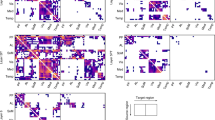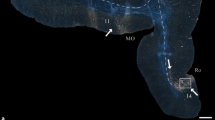Abstract
The aim of this chapter is to extend the standard simplified diagram of the connectional organization of the hippocampus found in many current textbooks, by adding details on the connectivity of area CA2 and on entorhinal intrinsic wiring. In the chapter, some of the ‘traditional wisdoms’ on hippocampal connectivity are discussed, emphasizing the need for a more inclusive framework to model the hippocampus. The chapter focusses on intrinsic connections, and many of the well-known extrinsic connections of the hippocampus will not be covered in this chapter, for two reasons. First, the information is already available at a summarized (meta) level, and a new summary would not assist those who need anatomical details to contribute to the explanation of the functional outcome of a study. Second, this chapter is meant to provide a framework of knowledge to support computational modelling of the region, and therefore only the most relevant and quantitative data on the connectivity of the hippocampus are covered.
Access this chapter
Tax calculation will be finalised at checkout
Purchases are for personal use only
Similar content being viewed by others
Notes
- 1.
The lateral and medial entorhinal cortex or Brodmann’s areas 28a and 28b, respectively, have been further subdivided by a large number of authors (for a more detailed description and comparison of different nomenclatures used in the rat and in other species, the reader is referred to a number of reviews (cf. Witter et al., 1989)). In the rat, and likewise in the mouse, a further division into dorsolateral (DLE), dorsal-intermediate (DIE), ventral-intermediate (VIE), caudal (CE) and medial (ME) subdivisions have been proposed (Insausti et al., 1997, Hippocampus 7:146; van Groen etal., 2003, Hippocampus 13: 133–149). In monkeys, humans and in other species in which the entorhinal cortex was described, such as cat, dog, guinea pig and bat (Amaral et al., 1987 J Comp Neurol 264: 326–355; Witter et al., 1989, Progr Neurobiol 33:161–254; Buhl and Dann 1991, Hippocampus 1: 131–152; Insausti et al., 1995, J Comp Neurol 355: 171–198; Uva et al., 2004 J Comp Neurol 474: 289–303; Woznicka et al. 2006, Brain Res Rev. 52: 346–367), comparable partitioning schemes have been proposed. However, in case of most species, there is a tendency to consider the entorhinal cortex as composed of two primary components, the lateral and medial entorhinal cortex, most likely reflecting functional differences (see further Witter et al. 2017a, Front Syst Neurosci 11:46).
- 2.
Note that some authors have adopted a slightly different nomenclature in which the lamina dissecans is either without number or considered to be the deep part of layer III (layer IIIb), such that layer IV is used to designate the superficial part of layer V, characterized by the presence of rather large pyramidal cells that stain strongly for Nissl substance.
- 3.
See Witter et al. 2017 Brain Behav Evol 90:15–24 for details on the complex and sometimes confusing terminology used to describe EC-HF projections.
- 4.
Note that the term temporo-ammonic tract is often used to refer to all of the entorhinal projections to the CA fields but more commonly only to all fibres that reach CA1. In the temporal portion of the hippocampus, most of the entorhinal fibres reach CA1 after perforating the subiculum (classical perforant pathway). At more septal levels, however, the number of entorhinal fibres that take the alvear temporo-ammonic pathway increases.
A third route taken by fibres from the entorhinal cortex involves the molecular layers of the entorhinal cortex, para- and presubiculum, continuing into the molecular layer of the subiculum. The latter route has not been given a specific name.
- 5.
The laminar pattern has been extensively described in the rat and available data in mice, guinea pigs and cats indicate a similar laminar terminal differentiation between the lateral and medial components of the perforant path. In contrast, in the macaque monkey the situation is different in that irrespective of the origin in EC, at all levels of the dentate gyrus, projections have been reported to distribute throughout the extent of the outer two-thirds of the molecular layer and stratum lacunosum –moleculare in CA3. It is important though that in all species information from functionally different entorhinal domains converges onto a single population of dentate and CA3 cells.
- 6.
In rodents, the layer II components from the LEC and the MEC apparently do not overlap with respect to their respective terminal zone in the molecular layer of the DG and likely the same holds true for CA3. It has not been established whether the same holds true for the respective layer III components, i.e. whether or not they have a zone of overlap in the centre part of CA1 or the Sub.
- 7.
Amygdala inputs reach only the ventral two-thirds of the CA1 and the Sub. The dorsal one-third of both fields is devoid of input from the amygdala.
Resources
http://www.temporal-lobe.com/: online searchable database of hippocampus connectivity and visualization tools
http://www.rbwb.org/: online atlas tools with detailed description of the anatomy of the hippocampal region in the rat
http://neuromorpho.org/index.jsp: index of morphologies of hippocampal neurons
Further Reading
Amaral DG, Witter MP (1989) The three-dimensional organization of the hippocampal formation: a review of anatomical data. Neuroscience 31:571–591
Amaral DG, Ishizuka N, Claiborne B (1990) Neurons, numbers and the hippocampal network. Progr Brain Res 83:1–11
Amaral DG, Scharfman HE, Lavenex P (2007) The dentate gyrus: fundamental neuroanatomical organization (dentate gyrus for dummies). Progr Br Res 163:3–22
Blaabjerg M, Zimmer J (2007) The dentate mossy fibers: structural organization, development and plasticity. Progr Br Res 163:85–107
Cameron HA, McKay RD (2001) Adult neurogenesis produces a large pool of new granule cells in the dentate gyrus. J Comp Neurol 435(4):406–417
Canto CB, Witter MP (2012a) Cellular properties of principal neurons in the rat entorhinal cortex. I The lateral entorhinal cortex. Hippocampus 22:1256–1276
Canto CB, Witter MP (2012b) Cellular properties of principal neurons in the rat entorhinal cortex. II The medial entorhinal cortex. Hippocampus 22:1277–1299
Canto CB, Wouterlood FG, Witter MP (2008) What does the anatomical organization of the entorhinal cortex tell us? Neural Plast 381243
Cappaert NLM, van Strien NM, Witter MP (2015) Hippocampal formation. In: Paxinos G (ed) The rat brain, 4th edn. Elsevier Academic, San Diego/London, pp 511–574
Dudek SM, Alexander GM, Farris S (2016 Feb) Rediscovering area CA2: unique properties and functions. Nat Rev Neurosci 17(2):89–102. https://doi.org/10.1038/nrn.2015.22
Gatome CW et al (2010) Number estimates of neuronal phenotypes in layer II of the medial entorhinal cortex of rat and mouse. Neuroscience 170:156
Hamam BN et al (2000) Morphological and electrophysiological characteristics of layer V neurons of the rat medial entorhinal cortex. J Comp Neurol 418:457
Haman BN et al (2002) Morphological and electrophysiological characteristics of layer V neurons of the rat lateral entorhinal cortex. J Comp Neurol 451:45
Jones MW, McHugh TJ (2011 Oct) Updating hippocampal representations: CA2 joins the circuit. Trends Neurosci 34(10):526–535. https://doi.org/10.1016/j.tins.2011.07.007
Klausberger T, Somogyi P (2008) Neuronal diversity and temporal dynamics: the unity of hippocampal circuit operations. Science 321:53–57
Lavenex P, Amaral DG (2000) Hippocampal-neocortical interaction: a hierarchy of associativity. Hippocampus 10:420
Matsuda S, Kobayashi Y, Ishizuka N (2004) A quantitative analysis of the laminar distribution of synaptic boutons in field CA3 of the rat hippocampus. Neurosci Res 29:241–252
Megias M, Emri ZS, Freund TF, Gulyas AI (2001) Total number and distribution of inhibitory and excitatory synapses on hippocampal CA1 pyramidal cells. Neuroscience 102:527–540
Merril DA, Chiba AA, Tuszynski MH (2001) Conservation of neuronal number and size in the entorhinal cortex in behaviorally characterized aged rats. J Comp Neurol 438:445–456
Rapp PR, Gallagher M (1996) Preserved neuron number in the hippocampus of aged rats with spatial learning deficits. Proc Natl Acad Sci U S A 93:9926–9930
Rapp PR, Deroche PS, Mao Y, Burwell RD (2002) Neuron number in the parahippocampal region is preserved in aged rats with spatial learning deficits. Cer Ctx 12:1171–1179
Rasmussen T, Schliemann T, Sørensen JC, Zimmer J, West MJ (1996) Memory impaired aged rats: no loss of principal hippocampal and subicular neurons. Neurobiol Ageing 17:143–147
Strange B, Witter MP, Moser EI, Lein E (2014) Functional organization of the hippocampal longitudinal axis. Nat Rev Neurosci 15:655–669
Tahvildari B, Alonso A (2005) Morphological and electrophysiological properties of lateral entorhinal cortex layers II and III principal neurons. J Comp Neurol 491:123
Van Strien NM, Cappeart N, Witter MP (2009) The anatomy of memory: an interactive overview of the parahippocampal-hippocampal network. Nat Rev Neurosci 10:272–282
West MJ et al (1991) Unbiased stereological estimation of the total number of neurons in thesubdivisions of the rat hippocampus using the optical fractionator. Anat Rec 231:482
Wickersham IR, Finke S, Conzelmann KK, Callaway EM (2007) Retrograde neuronal tracing with a deletion-mutant rabies virus. Nat Methods 4:47–49
Witter MP (2006) Connections of the subiculum of the rat: topography in relation to columnar and laminar organization. Behav Brain Res 174(2):251–264
Witter MP (2007a) Intrinsic and extrinsic wiring of CA3; indications for connectional heterogeneity. Learn Mem 14:705–713
Witter MP (2007b) The Perforant path. Projections from the entorhinal cortex to the dentate gyrus. Progr Br Res 163:43–61
Witter MP, Groenewegen HJ, Lopes da Silva FH, Lohman AHM (1989) Functional organization of the extrinsic and intrinsic circuitry of the parahippocampal region. Prog Neurobiol 33:161–253
Witter MP, Canto CB, Couey JJ, Koganezawa N, O’Reilly K (2014) Architecture of spatial circuits in the hippocampal region. Phil Trans R Soc B 369:20120515
Witter MP, Doan TP, Jacobsen B, Nilssen ES, Ohara S (2017a) Architecture of the entorhinal cortex. A review of entorhinal anatomy in rodents with some comparative notes. Front Syst Neurosci 11:46. https://doi.org/10.3389/fnsys.2017.00046
Witter MP, Kleven H, Kobro Flatmoen A (2017b) Comparative contemplations on the hippocampus. Brain Behav Evol 90:15–24. https://doi.org/10.1159/000475703
Zhang S-J, Ye J, Couey JJ, Witter MP, Moser EI, Moser M-B (2014) Functional connectivity of the entorhinal-hippocampal space circuit. Phil Trans R Soc B 369:20120516
Acknowledgements
The revision of this chapter has been supported by the Kavli Foundation, the Centre of Excellence scheme – Centre for Neural Computation and research grant # 191929 and 227769 of the Research Council of Norway and The Egil and Pauline Braathen and Fred Kavli Centre for Cortical Microcircuits.
Author information
Authors and Affiliations
Corresponding author
Editor information
Editors and Affiliations
Rights and permissions
Copyright information
© 2018 Springer Nature Switzerland AG
About this chapter
Cite this chapter
Witter, M.P. (2018). Connectivity of the Hippocampus. In: Cutsuridis, V., Graham, B., Cobb, S., Vida, I. (eds) Hippocampal Microcircuits. Springer Series in Computational Neuroscience. Springer, Cham. https://doi.org/10.1007/978-3-319-99103-0_1
Download citation
DOI: https://doi.org/10.1007/978-3-319-99103-0_1
Published:
Publisher Name: Springer, Cham
Print ISBN: 978-3-319-99102-3
Online ISBN: 978-3-319-99103-0
eBook Packages: Biomedical and Life SciencesBiomedical and Life Sciences (R0)




